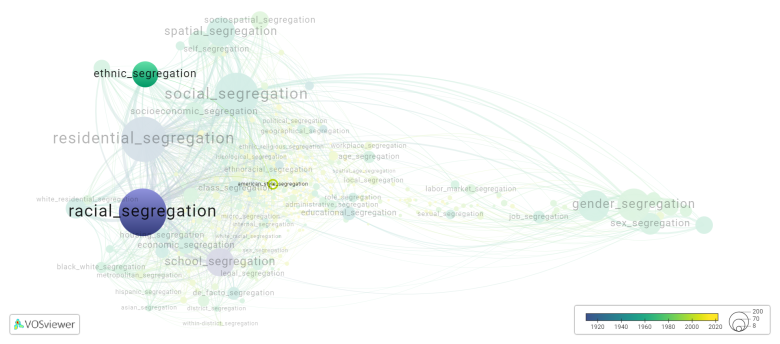American style segregation: Difference between revisions
(Creating page) |
(Creating page) |
||
| (8 intermediate revisions by the same user not shown) | |||
| Line 1: | Line 1: | ||
===== Date and country of first publication<ref>Date and country of first publication as informed by the Scopus database (December 2023).</ref>===== | |||
2009<br> | 2009<br> | ||
United Kingdom | United Kingdom | ||
===== Definition ===== | |||
American-style segregation refers to the practice of separating individuals or groups based on their race, ethnicity, or other characteristics, particularly in public spaces like schools, buses, neighborhoods, and public facilities. | American-style segregation refers to the practice of separating individuals or groups based on their race, ethnicity, or other characteristics, particularly in public spaces like schools, buses, neighborhoods, and public facilities. | ||
| Line 15: | Line 14: | ||
While American-style segregation is no longer legally mandated, systemic factors such as institutional racism, economic inequalities, and social biases contribute to ongoing patterns of segregation and unequal access to resources and opportunities. Efforts to address these issues continue, with civil rights organizations, activists, and policymakers advocating for policies and programs aimed at dismantling segregation and promoting equality. | While American-style segregation is no longer legally mandated, systemic factors such as institutional racism, economic inequalities, and social biases contribute to ongoing patterns of segregation and unequal access to resources and opportunities. Efforts to address these issues continue, with civil rights organizations, activists, and policymakers advocating for policies and programs aimed at dismantling segregation and promoting equality. | ||
==See also== | ==See also== | ||
==Related segregation forms== | |||
American style segregation is frequently discussed in the literature with the following segregation forms: | |||
[[ethnic segregation]], [[racial segregation]] | |||
[[File:american_style_segregation.png|780x780px]] | |||
This visualization is based on the study [[Segregation_Wiki:About| The Multidisciplinary Landscape of Segregation Research]]. | |||
For the complete network of interrelated segregation forms, please refer to: | |||
* [https://tinyurl.com/2235lkhw First year of publication] | |||
* [https://tinyurl.com/2d8wg5n3 Louvain clusters] | |||
* [https://tinyurl.com/223udk5r Betweenness centrality] | |||
* [https://tinyurl.com/244d8unz Disciplines in which segregation forms first emerged (Scopus database).] | |||
==References== | ==References== | ||
==Notes== | ==Notes== | ||
<references /> | <references /> | ||
== | {{NoteAI}} | ||
==American style segregation appears in the following literature== | |||
Peach C. (2009) | Peach C. (2009). Slippery segregation: Discovering or manufacturing ghettos?. ''Journal of Ethnic and Migration Studies'', ''35''(9), 1381-1395. https://doi.org/10.1080/13691830903125885 | ||
Latest revision as of 07:17, 16 October 2024
Date and country of first publication[1][edit | edit source]
2009
United Kingdom
Definition[edit | edit source]
American-style segregation refers to the practice of separating individuals or groups based on their race, ethnicity, or other characteristics, particularly in public spaces like schools, buses, neighborhoods, and public facilities.
Historically, American-style segregation refers to the system of racial segregation that was prevalent in the United States from the late 19th century to the mid-20th century. This system, commonly known as Jim Crow, enforced strict racial segregation laws and social norms, especially in the southern states where African Americans were subjected to discrimination and unequal treatment.
During this time, "separate but equal" was the legal principle that allowed for segregation, leading to the establishment of racially segregated schools, restrooms, public transportation, parks, and other public facilities. African Americans were often forced to use inferior facilities and endure systemic racial discrimination, contributing to the perpetuation of racial inequalities and limited opportunities.
Despite legal advancements such as the Civil Rights Act of 1964 and the Voting Rights Act of 1965, which aimed to end racial segregation and promote equal rights, remnants of segregation continue to persist today in more subtle and complex forms. Segregation can be seen in residential patterns, where racial and ethnic groups are often concentrated in specific neighborhoods due to historical and ongoing discriminatory practices, economic disparities, and social dynamics.
While American-style segregation is no longer legally mandated, systemic factors such as institutional racism, economic inequalities, and social biases contribute to ongoing patterns of segregation and unequal access to resources and opportunities. Efforts to address these issues continue, with civil rights organizations, activists, and policymakers advocating for policies and programs aimed at dismantling segregation and promoting equality.
See also[edit | edit source]
Related segregation forms[edit | edit source]
American style segregation is frequently discussed in the literature with the following segregation forms:
ethnic segregation, racial segregation

This visualization is based on the study The Multidisciplinary Landscape of Segregation Research.
For the complete network of interrelated segregation forms, please refer to:
References[edit | edit source]
Notes[edit | edit source]
- ↑ Date and country of first publication as informed by the Scopus database (December 2023).
At its current state, this definition has been generated by a Large Language Model (LLM) so far without review by an independent researcher or a member of the curating team of segregation experts that keep the Segregation Wiki online. While we strive for accuracy, we cannot guarantee its reliability, completeness and timeliness. Please use this content with caution and verify information as needed. Also, feel free to improve on the definition as you see fit, including the use of references and other informational resources. We value your input in enhancing the quality and accuracy of the definitions of segregation forms collectively offered in the Segregation Wiki ©.
American style segregation appears in the following literature[edit | edit source]
Peach C. (2009). Slippery segregation: Discovering or manufacturing ghettos?. Journal of Ethnic and Migration Studies, 35(9), 1381-1395. https://doi.org/10.1080/13691830903125885
